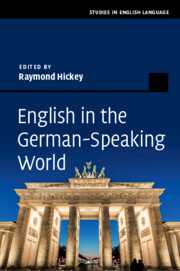Book contents
- English in the German-Speaking World
- Studies in English Language
- English in the German-Speaking World
- Copyright page
- Contents
- Figures
- Tables
- Contributors
- Preface
- Chapter 1 English in the German-Speaking World: The Nature and Scale of Language Influence
- I The Status of English
- II The Transmission of English
- III Domains and Features of English
- IV Beyond Germany
- Index
- References
Chapter 1 - English in the German-Speaking World: The Nature and Scale of Language Influence
Published online by Cambridge University Press: 11 November 2019
- English in the German-Speaking World
- Studies in English Language
- English in the German-Speaking World
- Copyright page
- Contents
- Figures
- Tables
- Contributors
- Preface
- Chapter 1 English in the German-Speaking World: The Nature and Scale of Language Influence
- I The Status of English
- II The Transmission of English
- III Domains and Features of English
- IV Beyond Germany
- Index
- References
Summary
English is a presence which cannot be denied in so many countries of today’s world (Schneider 2017, 2020) and hence it is not a matter of whether it has an influence on non-English speaking countries but what the scale and nature of this influence is (Hilgendorf 2007). In the German-speaking world there is an asymmetrical relationship between English and German despite the undisputed status of German as a major European language. With many languages there is often a resistance in society to the overwhelming influence of English, and in Germany there have been, and still are, ideological debates surrounding the many borrowings from English into German (see Mair, this volume, for instance). The extent of the influence exercised by English varies across different social domains, it being particularly strong in areas such as advertising, technology and science, though for different reasons. While in advertising the use of English is supposed to index sophistication and urbanity, for technology and science (Ammon 2004) its use derives from source research and innovation which is already embedded in an English-language context. In wider social areas, in the domestic and familiar domains, the occurrence of English is less obvious as it is confined to lexical items transferred to German. However, it is these larger domains which determine whether English material used in a German context will actually become established as permanent borrowings. Here language attitudes and comprehension issues in the initial appearance of English lexis shape the reality of language use.
- Type
- Chapter
- Information
- English in the German-Speaking World , pp. 1 - 10Publisher: Cambridge University PressPrint publication year: 2019
References
- 3
- Cited by



